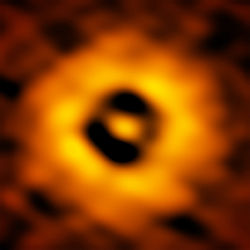| Observation data Epoch J2000.0 Equinox J2000.0 | |
|---|---|
| Constellation | Hydra |
| Right ascension | 11h 01m 51.9054s[1] |
| Declination | −34° 42′ 17.0316″[1]> |
| Apparent magnitude (V) | 11.27 ± 0.09[2] |
| Characteristics | |
| Evolutionary stage | Pre-main-sequence |
| Spectral type | K6[2] |
| U−B color index | -0.33[3] |
| B−V color index | 0.67[2] |
| J−H color index | 0.659[2] |
| J−K color index | 0.92[2] |
| Variable type | T Tauri |
| Astrometry | |
| Radial velocity (Rv) | 13.40 ± 0.8[2] km/s |
| Proper motion (μ) | RA: −68.389 ± 0.054[1] mas/yr Dec.: −14.016 ± 0.059[1] mas/yr |
| Parallax (π) | 16.6428 ± 0.0416 mas[1] |
| Distance | 196.0 ± 0.5 ly (60.1 ± 0.2 pc) |
| Details | |
| Mass | 0.8[4] M☉ |
| Radius | 1.11[5] R☉ |
| Luminosity (bolometric) | 0.28[note 1] L☉ |
| Temperature | 4,000[5] K |
| Age | 8[5] Myr |
| Other designations | |
| Database references | |
| SIMBAD | data |
TW Hydrae is a T Tauri star approximately 196 light-years away[1] in the constellation of Hydra (the Sea Serpent). TW Hydrae is about 80% of the mass of the Sun, but is only about 5-10 million years old. The star appears to be accreting from a protoplanetary disk of dust and gas, oriented face-on to Earth, which has been resolved in images from the ALMA observatory. TW Hydrae is accompanied by about twenty other low-mass stars with similar ages and spatial motions, comprising the "TW Hydrae association" or TWA, one of the closest regions of recent "fossil" star-formation to the Sun.
- ^ a b c d e f Cite error: The named reference
Gaia DR2was invoked but never defined (see the help page). - ^ a b c d e f Cite error: The named reference
SIMBADwas invoked but never defined (see the help page). - ^ Cite error: The named reference
Mermilliod1991+2006was invoked but never defined (see the help page). - ^ Cite error: The named reference
Chunhua2013was invoked but never defined (see the help page). - ^ a b c Cite error: The named reference
Rheeetal2007was invoked but never defined (see the help page).
Cite error: There are <ref group=note> tags on this page, but the references will not show without a {{reflist|group=note}} template (see the help page).
